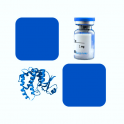
- Remove this product from my favorite's list.
- Add this product to my list of favorites.
Products
Viewed products
Newsletter
 |  |  |  |  |  |

Background
Tyrosine-protein kinase transmembrane receptor ROR1 is also known as Neurotrophic tyrosine kinase, receptor-related 1 (NTRKR1), which belongs to the protein kinase superfamily or tyr protein kinase family or ROR subfamily. ROR1 contains 1 FZ (frizzled) domain, 1 Ig-like C2-type (immunoglobulin-like) domain, 1 kringle domain, 1 protein kinase domain. ROR1 is expressed at high levels during early embryonic development. The expression levels drop strongly around day 16 and there are only very low levels in adult tissues. Isoform Short is strongly expressed in fetal and adult CNS and in a variety of human cancers, including those originating from CNS or PNS neuroectoderm. ROR1 could interact with casein kinase 1 epsilon (CK1ε) to activate phosphoinositide 3-kinase-mediated AKT phosphorylation and cAMP-response-element-binding protein (CREB), which was associated with enhanced tumor-cell growth.
Source
Recombinant Biotinylated Human / Cynomolgus / Rhesus macaque ROR1, Avitag (RO1-H821y) is expressed from human 293 cells (HEK293). It contains AA Gln 30 - Glu 403 (Accession # Q01973-1). In the region Gln 30 - Glu 403, the AA sequence of Human, Cynomolgus and Rhesus macaque ROR1 are homologus.
Predicted N-terminus: Gln 30
Molecular Characterization
This protein carries an Avi tag at the C-terminus.
The protein has a calculated MW of 45.2 kDa. The protein migrates as 55-66 kDa under reducing (R) condition (SDS-PAGE) due to glycosylation.
Biotinylation
Biotinylation of this product is performed using Avitag™ technology. Briefly, the single lysine residue in the Avitag is enzymatically labeled with biotin.
Biotin:Protein Ratio
Passed as determined by the HABA assay / binding ELISA.
Endotoxin
Less than 1.0 EU per μg by the LAL method.
Purity
>95% as determined by SDS-PAGE.
Formulation
Lyophilized from 0.22 μm filtered solution in PBS, pH7.4. Normally trehalose is added as protectant before lyophilization.
Reconstitution
Please see Certificate of Analysis for specific instructions.
For best performance, we strongly recommend you to follow the reconstitution protocol provided in the CoA.
Storage
For long term storage, the product should be stored at lyophilized state at -20°C or lower.
Please avoid repeated freeze-thaw cycles.
This product is stable after storage at:
-20°C to -70°C for 12 months in lyophilized state;
-70°C for 3 months under sterile conditions after reconstitution.
Bioactivity
Please refer to product data sheet.
(1) "Association of baseline ROR1 and ROR2 gene expression with clinical outcomes in the I-SPY2 neoadjuvant breast cancer trial"
Parker, Shatsky, Schwab et al
Breast Cancer Res Treat (2023)
(2) "Current progress in chimeric antigen receptor-modified T cells for the treatment of metastatic breast cancer"
Yin, Chen, Xiang et al
Biomed Pharmacother (2023) 162, 114648
(3) "Future potential targets of antibody-drug conjugates in breast cancer"
Corti, Boscolo Bielo, Schianca et al
Breast (2023) 69, 312-322
Showing 1-3 of 508 papers.
Recombinant Human ROR1 Protein, full ECD, Fc Tag (MALS verified) DMF Filed, 200 µg - 338,00 €
Recombinant Mouse ROR1 Protein, full ECD, His tag, 100 µg - 494,00 €
Recombinant Mouse CD3 epsilon&CD3 delta Heterodimer Protein, His Tag&Flag Tag, 100 µg - 533,00 €
Recombinant Rat ROR1 Protein, full ECD, His tag, 100 µg - 468,00 €
Recombinant Human ROR2 / NTRKR2 Protein, full ECD, His tag, 50 µg - 494,00 €
Recombinant Human ROR2 / NTRKR2 Protein, full ECD, Fc Tag, 50 µg - 390,00 €
Recombinant Human ROR1 Protein (Ig-like domain), His tag, 50 µg - 494,00 €
Follow us